What Other Accessibility Requirements Apply to Play Components?
The play area guidelines address accessible routes connecting play components along with certain spaces that are crucial to making a play area usable for children with disabilities. The other requirements for play components are provided to promote general usability, with application to a variety of play components. Additional features will assist in making play components more accessible to more children. Designers are encouraged to consider components with back support, increased space for maneuvering adjacent to the play component, and other features that promote independent use.
Clear Floor or Ground Space
Clear floor space - also known as ground space - provides unobstructed room to accommodate a single stationary wheelchair and its occupant at a play component on an accessible route. Clear floor or ground space is also sometimes called "wheelchair parking space."
- 30-inch (760 mm) by 48-inch (1220 mm) minimum area
- May overlap accessible routes and maneuvering spaces
- Slope not steeper than 1:48 in all directions
Play components come in a variety of shapes and sizes facilitating a broad range of experiences. A specific location for clear floor or ground space has not been designated. Each play component is unique and the spaces must be placed in the best location for the situation.
The minimum clear floor or ground space on a composite structure may be positioned for a forward or parallel approach. It may overlap accessible routes and maneuvering spaces. Elevated play components accessed by transfer systems do not require maneuvering or clear floor spaces, since mobility devices are left at ground level.
Maneuvering Space
Maneuvering space is defined as the space required for a wheelchair to make a 180-degree turn. At least one maneuvering space must be provided on the same level as elevated play components.
When providing access to ground level and elevated play components by ramps, space allowances to accommodate wheelchairs and mobility devices are required.
-
A 60-inch (1525 mm) turning circle permits individuals with mobility devices to turn around
-
A 60-inch (1525 mm) T-Shaped turn allows an individual to change directions by making a series of multi-point turns
-
Slope not steeper than 1:48 in all directions
As an example, maneuvering space is required for swings and may be located behind or in front, as long as it is immediately adjacent to the swing. Objects are not permitted to protrude into ground level maneuvering spaces at or below 80 inches (2030 mm) above the ground or floor surface.
Entry Points and Seats
Entry points and seats are features of play components where individuals would transfer, sit, or gain access. When play components are located on an accessible route, the height required to transfer directly to the entry point or seat of a play component has a minimum of 11 inches (280 mm) and a maximum of 24 inches (610 mm). A mid-level height of 18 inches (455 mm) is recommended. The height of the entry point of a slide is not specified.
Examples of entry points and seats include swing seats, spring rocker seats, and crawl-tube openings (left). Consider design features like open sides, back supports, and hand supports (right) to help facilitate easy transfer and access.
Play Tables
Play tables are surfaces, boards, slabs, or counters that are created for play. This includes tables designed for sand and water play, gathering areas, and other activities. Where play tables are located on an accessible route, the wheelchair knee clearance minimums are:
-
24 inches (610 mm) high minimum
-
30 inches (760 mm) wide minimum
-
17 inches (430 mm) deep minimum
Play tables designed primarily for children under 5 years old may provide a parallel approach instead of knee clearance if the rim is a maximum of 31 inches (785 mm) high. The tops of rims, curbs, or other obstructions that would prevent access to a table surface should be 31 inches (785 mm) maximum in height.
Play tables may be located at a ground or elevated level in a composite play structure. Consider the route, clear floor space and maneuvering spaces for tables intended to be accessible to individuals who use wheelchairs.
Reach Ranges (Advisory)
The play area guidelines include advisory information on recommended reach ranges. Reach ranges are the recommended designated regions of space that a person seated in a wheelchair can reasonably extend their arm or hand to touch, manipulate, move, or interact with an object or play component.
Reach ranges should be considered when providing play components with manipulative or interactive features for children who use wheelchairs. Recommended forward or side reach ranges are:
-
20 to 36 inches for 3 to 4 year-olds
-
18 to 40 inches for 5 to 8 year-olds
-
16 to 44 inches for 9 to 12 year-olds
Side Reach
Forward Reach
The reach ranges appropriate for use by children who use wheelchairs to access play components are intended for ground-level components, and elevated components accessed by ramps. Reach ranges are not appropriate for play components reached by transfer systems. Appropriate reach range heights will vary depending on how the play component is accessed. This interactive panel (right) is mounted at a height appropriate for a child who uses a wheelchair.
The reach ranges in this guide are recommendations that should be considered when designing play components with manipulative features intended for use by individuals who use wheelchairs.

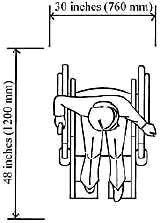
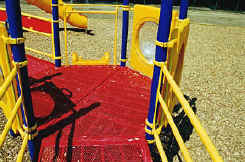
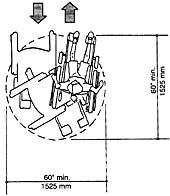
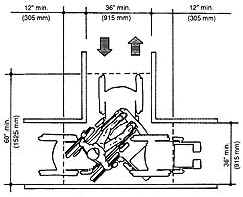
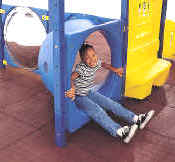
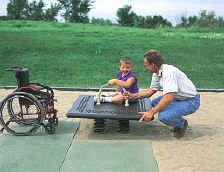
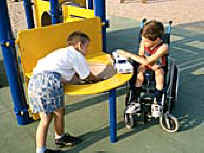
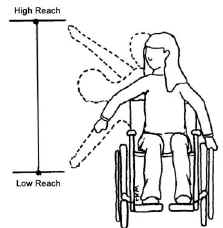
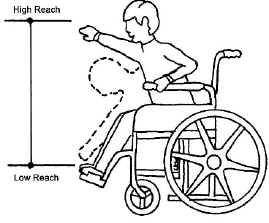
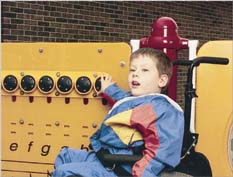
User Comments/Questions
Add Comment/Question